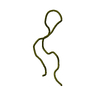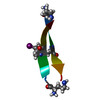[English] 日本語
 Yorodumi
Yorodumi- PDB-1g9w: STRUCTURAL BASIS OF COLLAGEN STABILIZATION INDUCED BY PROLINE HYD... -
+ Open data
Open data
- Basic information
Basic information
| Entry | Database: PDB / ID: 1g9w | ||||||
|---|---|---|---|---|---|---|---|
| Title | STRUCTURAL BASIS OF COLLAGEN STABILIZATION INDUCED BY PROLINE HYDROXYLATION | ||||||
 Components Components | (COLLAGEN-LIKE PEPTIDE) x 2 | ||||||
 Keywords Keywords | STRUCTURAL PROTEIN / COLLAGEN / EXTRACELLULAR MATRIX | ||||||
| Method |  X-RAY DIFFRACTION / X-RAY DIFFRACTION /  SYNCHROTRON / Resolution: 1.3 Å SYNCHROTRON / Resolution: 1.3 Å | ||||||
 Authors Authors | Vitagliano, L. / Berisio, R. / Mazzarella, L. / Zagari, A. | ||||||
 Citation Citation |  Journal: Biopolymers / Year: 2001 Journal: Biopolymers / Year: 2001Title: Structural bases of collagen stabilization induced by proline hydroxylation. Authors: Vitagliano, L. / Berisio, R. / Mazzarella, L. / Zagari, A. #1:  Journal: Acta Crystallogr.,Sect.D / Year: 2000 Journal: Acta Crystallogr.,Sect.D / Year: 2000Title: Effects of microgravity on the crystal quality of a collagen-like polypeptide Authors: Berisio, R. / Vitagliano, L. / Sorrentino, G. / Carotenuto, L. / Piccolo, C. / Mazzarella, L. / Zagari, A. #2:  Journal: J.Mol.Biol. / Year: 1998 Journal: J.Mol.Biol. / Year: 1998Title: X-RAY CRYSTALLOGRAPHIC DETERMINATION OF A COLLAGEN-LIKE PEPTIDE WITH THE REPEATING SEQUENCE (PRO-PRO-GLY) Authors: Kramer, R.Z. / Vitagliano, L. / Bella, J. / Berisio, R. / Mazzarella, L. / Brodsky, B. / Zagari, A. / Berman, H.M. | ||||||
| History |
|
- Structure visualization
Structure visualization
| Structure viewer | Molecule:  Molmil Molmil Jmol/JSmol Jmol/JSmol |
|---|
- Downloads & links
Downloads & links
- Download
Download
| PDBx/mmCIF format |  1g9w.cif.gz 1g9w.cif.gz | 15.2 KB | Display |  PDBx/mmCIF format PDBx/mmCIF format |
|---|---|---|---|---|
| PDB format |  pdb1g9w.ent.gz pdb1g9w.ent.gz | 11.3 KB | Display |  PDB format PDB format |
| PDBx/mmJSON format |  1g9w.json.gz 1g9w.json.gz | Tree view |  PDBx/mmJSON format PDBx/mmJSON format | |
| Others |  Other downloads Other downloads |
-Validation report
| Summary document |  1g9w_validation.pdf.gz 1g9w_validation.pdf.gz | 345.6 KB | Display |  wwPDB validaton report wwPDB validaton report |
|---|---|---|---|---|
| Full document |  1g9w_full_validation.pdf.gz 1g9w_full_validation.pdf.gz | 345.6 KB | Display | |
| Data in XML |  1g9w_validation.xml.gz 1g9w_validation.xml.gz | 1.5 KB | Display | |
| Data in CIF |  1g9w_validation.cif.gz 1g9w_validation.cif.gz | 2.1 KB | Display | |
| Arichive directory |  https://data.pdbj.org/pub/pdb/validation_reports/g9/1g9w https://data.pdbj.org/pub/pdb/validation_reports/g9/1g9w ftp://data.pdbj.org/pub/pdb/validation_reports/g9/1g9w ftp://data.pdbj.org/pub/pdb/validation_reports/g9/1g9w | HTTPS FTP |
-Related structure data
| Related structure data | |
|---|---|
| Similar structure data |
- Links
Links
- Assembly
Assembly
| Deposited unit | 
| ||||||||
|---|---|---|---|---|---|---|---|---|---|
| 1 |
| ||||||||
| Unit cell |
| ||||||||
| Details | THE 21 RESIDUE ASYMMETRIC UNIT CORRESPONDS TO ONE TRIPLE-HELICAL REPEAT AND IS SMALLER THAN THE ENTIRE 90 RESIDUE PEPTIDE. THE RESULT IS A POLYMER-LIKE STRUCTURE WITH NO DEFINED ENDS. THE POLYMER STRUCTURE IS FORMED BY CONTINUATION OF THE CHAINS USING THE SYMMETRY-RELATED MOLECULES ALONG THE HELICAL AXIS. THE TVECT RECORD BELOW PRESENTS THE TRANSLATION THAT WILL GENERATE THE POLYMER. NOTE: THEREFORE, CLOSE CONTACTS BETWEEN SYMMETRY-RELATED MOLECULES ARE INTENTIONAL AND NECESSARY. INTERCHAIN HYDROGEN BONDING AT THE END OF CHAINS ALSO UTILIZES SYMMETRY-RELATED MOLECULES. THE ENTIRE 30 RESIDUE LONG PEPTIDE CAN BE GENERATED FROM THE SUBMITTED ASYMMETRIC UNIT BY APPLYING THE FOLLOWING TRANSLATIONS (USING FRACTIONAL COORDINATES): CHAIN A: TRANSLATE RESIDUES 1 - 9 BY (0 0 1), (0 0 2), AND (0 0 3) AND RESIDUES 7 - 9 BY (0 0 4). CHAIN B: TRANSLATE RESIDUES 31 - 36 BY (0 0 1), (0 0 2), AND (0 0 3). CHAIN C: TRANSLATE RESIDUES 61 - 66 BY (0 0 1), (0 0 2), AND (0 0 3) AND RESIDUES 64 - 66 BY (004). THIS WILL RESULT IN A MOLECULE WITH A TOTAL OF 90 RESIDUES, 30 IN EACH CHAIN. |
- Components
Components
| #1: Protein/peptide | Mass: 771.859 Da / Num. of mol.: 1 / Source method: obtained synthetically | ||||||
|---|---|---|---|---|---|---|---|
| #2: Protein/peptide | Mass: 520.578 Da / Num. of mol.: 2 / Source method: obtained synthetically #3: Water | ChemComp-HOH / | Compound details | HYDROGEN BONDS BETWEEN PEPTIDE CHAINS FOLLOW THE RICH AND CRICK MODEL II FOR COLLAGEN. | Sequence details | FOR EACH CHAIN, RESIDUE NUMBERING CORRESPOND | |
-Experimental details
-Experiment
| Experiment | Method:  X-RAY DIFFRACTION / Number of used crystals: 1 X-RAY DIFFRACTION / Number of used crystals: 1 |
|---|
- Sample preparation
Sample preparation
| Crystal | Density Matthews: 1.97 Å3/Da / Density % sol: 37.43 % | ||||||||||||||||||||
|---|---|---|---|---|---|---|---|---|---|---|---|---|---|---|---|---|---|---|---|---|---|
| Crystal grow | Temperature: 293 K / Method: dialysis Details: SODIUM ACETATE, ACETIC ACID, DIALYSIS, temperature 293K | ||||||||||||||||||||
| Crystal grow | *PLUS Method: vapor diffusion, hanging drop / Details: Kramer, R.Z., (1998) J.Mol.Biol., 280, 623. | ||||||||||||||||||||
| Components of the solutions | *PLUS
|
-Data collection
| Diffraction | Mean temperature: 293 K |
|---|---|
| Diffraction source | Source:  SYNCHROTRON / Site: SYNCHROTRON / Site:  ELETTRA ELETTRA  / Beamline: 5.2R / Wavelength: 1.004 / Beamline: 5.2R / Wavelength: 1.004 |
| Detector | Type: MARRESEARCH / Detector: IMAGE PLATE / Date: Dec 1, 1998 |
| Radiation | Protocol: SINGLE WAVELENGTH / Monochromatic (M) / Laue (L): M / Scattering type: x-ray |
| Radiation wavelength | Wavelength: 1.004 Å / Relative weight: 1 |
| Reflection | Resolution: 1.3→15 Å / Num. obs: 3448 / % possible obs: 89 % / Redundancy: 4.8 % / Rmerge(I) obs: 0.042 |
| Reflection shell | Resolution: 1.3→1.33 Å / Rmerge(I) obs: 0.093 / % possible all: 66.4 |
| Reflection shell | *PLUS % possible obs: 66.4 % |
- Processing
Processing
| Software |
| ||||||||||||||||||||
|---|---|---|---|---|---|---|---|---|---|---|---|---|---|---|---|---|---|---|---|---|---|
| Refinement | Starting model: PDB1A3J.ENT Resolution: 1.3→10 Å / Num. parameters: 147 / Num. restraintsaints: 179 / Cross valid method: THROUGHOUT / σ(I): 0 / Stereochemistry target values: ENGH AND HUBER Details: DUE TO THE QUASI-INFINITE NATURE OF THE TRIPLE HELIX, DURING REFINEMENT COVALENT BONDS ARE NECESSARY TO JOIN THE MOLECULE WITH ITS SYMMETRY MATES BOTH ABOVE IT AND BELOW IT ALONG THE HELICAL ...Details: DUE TO THE QUASI-INFINITE NATURE OF THE TRIPLE HELIX, DURING REFINEMENT COVALENT BONDS ARE NECESSARY TO JOIN THE MOLECULE WITH ITS SYMMETRY MATES BOTH ABOVE IT AND BELOW IT ALONG THE HELICAL AXIS AND TIGHT REFINEMENT CONSTRAINTS WERE MAINTAINED. THE UNIT CELL AXES WERE CHOSEN TO COINCIDE WITH A PREVIOUS STRUCTURE DETERMINATION (OKUYAMA 1981) OF THIS PEPTIDE.
| ||||||||||||||||||||
| Refine analyze | Occupancy sum non hydrogen: 162 | ||||||||||||||||||||
| Refinement step | Cycle: LAST / Resolution: 1.3→10 Å
| ||||||||||||||||||||
| Refine LS restraints |
| ||||||||||||||||||||
| Software | *PLUS Name: SHELXL-97 / Classification: refinement | ||||||||||||||||||||
| Refine LS restraints | *PLUS
|
 Movie
Movie Controller
Controller












 PDBj
PDBj

